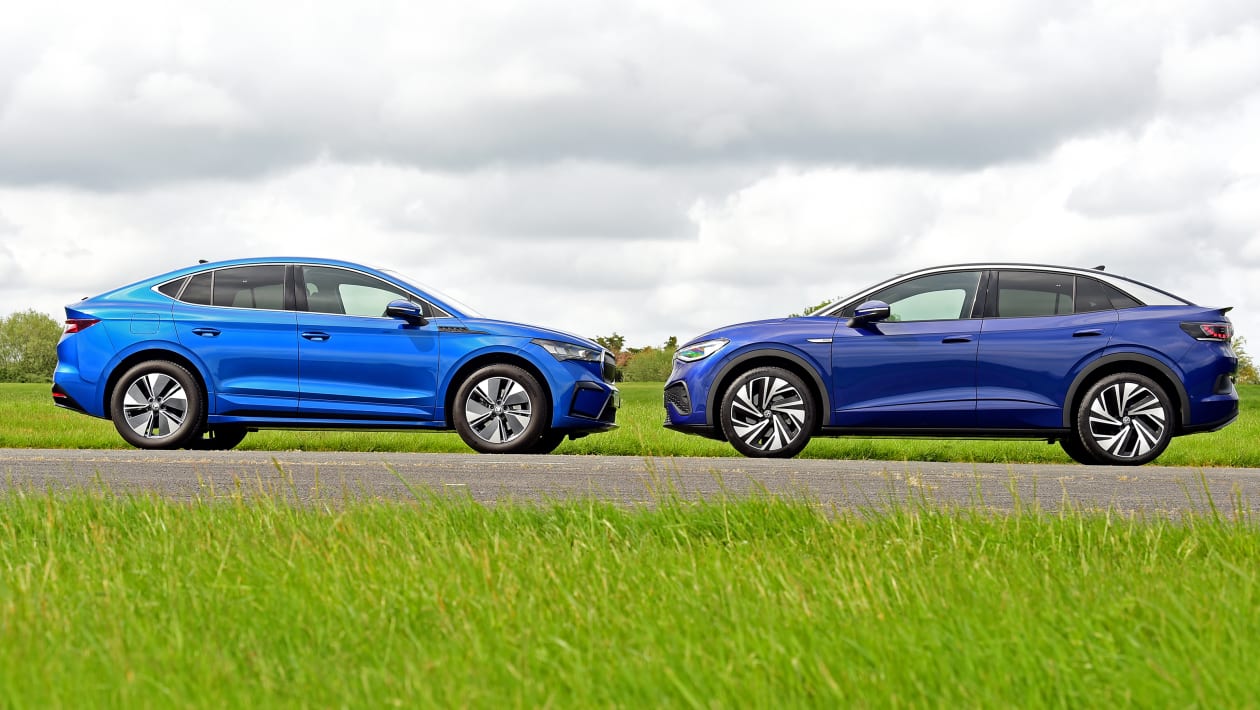Skoda Enyaq iV vs Volkswagen ID.5: 2023 twin test review

The coupe-SUV[1] was at first something of a niche, when premium manufacturers tried to make more rakish spin-offs of their traditional high-rise models. However, when it comes to squeezing out every last possible mile of range from an electric[2] powertrain, manufacturers have become even more open to the idea.
Volkswagen[3] got in on the act early on, with the swoopy ID.5[4] following not long after the launch of the more conventionally shaped ID.4[5]. The pair are virtually identical up to the B-pillars, at which point the ID.5’s roof drops down more dramatically. The result is measurable; a drag coefficient of 0.26Cd beats the ID.4’s 0.28Cd – something that will pay dividends for efficiency, particularly at a high-speed cruise.
Despite that roofline, interior space isn’t particularly compromised. VW states that there’s 12mm less headroom than in the ID.4, while kneeroom is simply vast. With a boot volume of 549 litres, an increase of six litres over the ID.4 is claimed.
Because the Enyaq[6] and Enyaq Coupe[7] share the same MEB architecture as the VW, all the same benefits apply to Skoda[8]’s challenger. Efficiency impresses in both cars, with a claimed 300-mile-plus range translating into an easy 260-270 miles in the real world, if you go for the larger 77kWh battery option and rear-wheel-drive[9] powertrain – the spec used by each of the models in these pictures.
On the road, both focus on comfort over fun; they ride well (even on the ID.5’s optional 21-inch wheels) and prove to be easygoing – if not as fast as a 201bhp electric motor would lead you to expect.
The Skoda, however, has a slight edge in one or two areas. The VW’s boot is large, but at 570 litres, the Enyaq’s is even better. Yet it’s further forward in the cabin where the Skoda has a real advantage. There are similarities in the pair’s layouts, but to our eyes the Enyaq is better resolved.
Its compact 5.3-inch digital driver’s display is neatly integrated into a small binnacle; not only does it look less like an afterthought than the VW’s ‘stuck-on’ screen, but it also provides some shade to avoid possible glare. The temperature controls, although mostly based on the screen, are less fiddly to use than the VW’s touch- sensitive slider panel below its display, and the Skoda gets a switch for each electric window, instead of the ID.5’s dual-function front/rear selector.
More surprisingly, the Skoda feels the more expensive car of the two. The steering wheel is great to hold and the door panels have plenty of soft-touch materials – two things that the VW struggles to offer. And despite this, the Skoda is much stronger value for money on a monthly finance deal.
Match the pair on a three-year PCP[10] with a £5,000 deposit and a 10,000-mile annual limit, and the Enyaq Coupe iV 80 comes to £619 per month, undercutting the ID.5 Style Pro Performance by £98 per month, despite that car having a £1,750 deposit contribution from VW.
Results
Which car comes out on top?
Winner: Skoda Enyaq iV
It’s easy to see why the Enyaq is such a competent all-rounder in this sector. It manages to flaunt all the strengths of MEB-based cars – space and comfort in particular – in a package that will feel entirely familiar to any owners of combustion-engined Skoda models. It’s competitively priced for the class, too.
Pros
Cons
Comfort and refinement
135kW charging is slower than in some rivals
Expensive-feeling cabin
Underwhelming performance
Runner up: Volkswagen ID.5
Despite VW taking a near-identical starting point, in many places it seems as though Skoda has made better use of the MEB platform. The ID.5 feels similarly relaxing and comfortable to drive, but it’s the aspects that you can see and touch – in particular, the cabin and infotainment – that VW needs to improve.
Pros
Cons
Superb interior space
Underwhelming cabin quality for a high price
Efficient powertrain
Poor ergonomics
Figures
Skoda Enyaq Coupe iV Suite 80
Volkswagen ID.5 Tech Pro Performance
On-the-road price
£46,205
£55,580
Powertrain
1x electric motor/lithium-ion battery
1x electric motor/lithium-ion battery
Power/torque
201bhp/310Nm
201bhp/310Nm
Transmission
Single-speed auto/rwd
Single-speed auto/rwd
Length/wheelbase
4,653/2,765mm
4,599/2,771mm
Height/width
1,622/1,879mm
1,616/1,852mm
Boot capacity (seats up/down)
570/1,610 litres
549/1,561 litres
Kerbweight/payload
2,107/508kg
2,118/532kg
Battery capacity
77kWh
77kWh
Basic warranty (miles)/recovery
3yrs (60,000)/3yrs
3yrs (60,000)/1yr
NCAP: Adult/child/ped./assist/stars
94/89/71/82/5 (2021)
93/89/76/85/5 (2021)
0-62mph/top speed
8.5 seconds/99mph
8.4 seconds/99mph
WLTP economy (miles/kWh)/range
4.0/345 miles
3.9/323 miles
Claimed CO2/tax bracket
0g/km/2%
0g/km/2%
Airbags/Isofix/park sensors/camera
Seven/three/f&r/yes
Seven/three/f&r/yes
Lane assist/blindspot/AEB
Yes/£2,755 (pack)/yes
Yes/yes/yes
Climate control/cruise control
2-zone/yes
3-zone/adaptive
Leather/heated seats/met paint
Faux/£2,755 (pack)/£660
No/yes/£710
LED lights/keyless go/power boot
Y/£2,755 (pck)/£4,830 (pck)
Matrix/yes/yes
Sat-nav/digital dash
Yes/yes
Yes/yes
Wireless charge/CarPlay/Android
£2,755 (pack)/2x wireless
Yes/wireless/wireless
References
- ^ SUV (www.autoexpress.co.uk)
- ^ electric (www.autoexpress.co.uk)
- ^ Volkswagen (www.autoexpress.co.uk)
- ^ ID.5 (www.autoexpress.co.uk)
- ^ ID.4 (www.autoexpress.co.uk)
- ^ Enyaq (www.autoexpress.co.uk)
- ^ Enyaq Coupe (www.autoexpress.co.uk)
- ^ Skoda (www.autoexpress.co.uk)
- ^ rear-wheel-drive (www.autoexpress.co.uk)
- ^ PCP (www.autoexpress.co.uk)